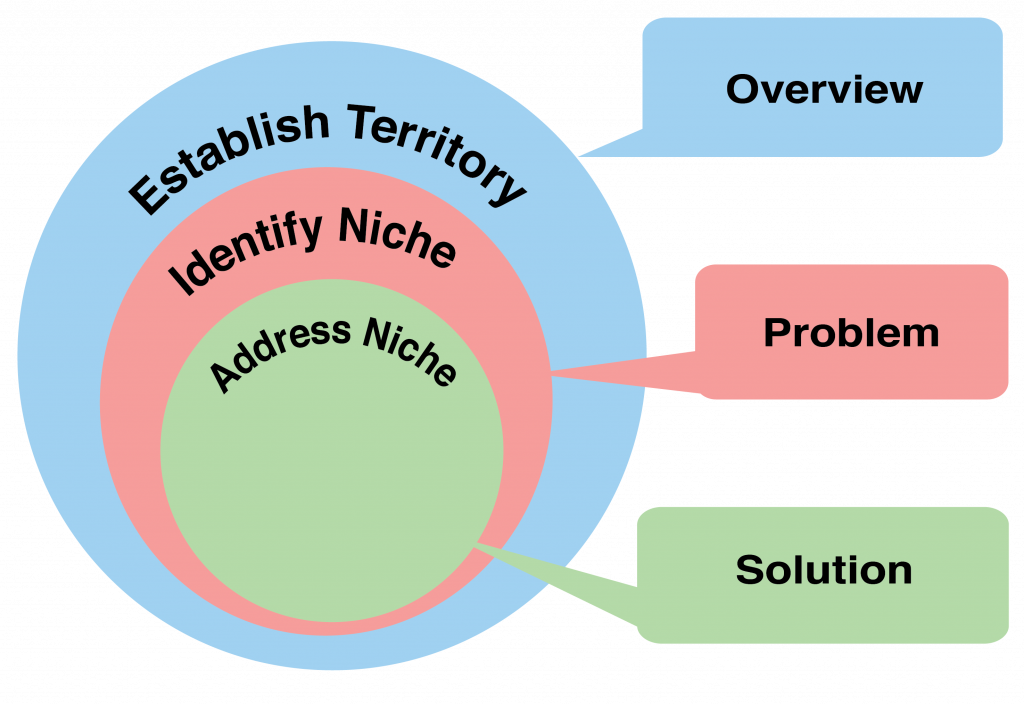Chapter 3: Writing the Introduction Section
Introduction Goal 1: Establishing a Knowledge Territory
The first goal of writing an Introduction is Establishing a Knowledge Territory, which means that you explain to your reader the big picture of where your study fits in the literature. To accomplish this goal, you must demonstrate knowledge of the topic and its relevance to the field. In other words, you are establishing how your expertise fits into an existing body of work.
Overall, Goal 1 (Establishing a Knowledge Territory) presents information, generally known background, and previous research on the topic of your research. It is the broadest part of an Introduction, so as you are writing, be sure to keep the information general.
Here are some excerpts from research articles with the key language in bold, because it is the best clue for linking words or phrases to a communicative goal:
 Examples
Examples
-
- Wood pellet production is a well-established and rapidly expanding industry worldwide, including in the United States and Canada where the annual production is nearing 4 million metric tons. In the province of British Columbia, the industry has grown from 50,000 tons in 1996 to an expected 1,500,000 tons in 2010.[1]
- Legionellae are widespread in both natural and man-made aquatic habitats. Among the 51 species described so far, Legionella pneumophila is the most causative agent of legionellosis, but it is often difficult to isolate from environmental samples because of the presence of heterotrophic-associated bacteria that frequently overgrow on culture plates.[2]
- It is well known that having strong and supportive social relations is beneficial for several different outcomes (House et al., 1988; Call and Mortimer, 2001; Malecki and Demaray, 2003; Cohen, 2004). We also know that social background influences our living conditions and opportunities in several ways (Breen and Jonsson, 2005; Conger and Donnellan, 2007).[3]
The bolded phrases in the list above are language cues demonstrating how the writers accomplish the communicative goal of establishing the territory. There are many other ways to achieve the same goal, and you can find extensive lists of such phrases by visiting Manchester’s Academic Phrasebank website, which we will refer to repeatedly in this book.
Goal 1 prepares your reader to understand your research better by describing what is generally known and what has been previously researched. Imagine it as the foundation upon which you are going to build the house of your research. Unlike architectural foundations, however, the foundation of your research (as laid out in the Introduction) is on display for all to see. In fact, in this foundation, your aim as a writer is also to attract the reader, draw them into the research, and maintain their interest.
Goal 1 Strategies
Goal 1, “Establishing a Knowledge Territory,” means that you demonstrate knowledge of the topic and its relevance in the field. There are three strategies that will help you to accomplish this:

Strategies for Introduction Communicative Goal 1: Establishing a Knowledge Territory
- Claim centrality of your topic
- Provide relevant general background
- Review informative previous research
We’ll now discuss each of these and provide some examples from published journal articles.
Introduction Goal 1 Strategy: Claiming Centrality
 Examples
Examples
- Meat tenderness is an important issue in beef cattle because it has a major impact on consumer satisfaction. However, beef meat quality is not routinely measured, so a classical selection based on records is not feasible.[4]
- The emission from low-mass X-ray binaries in quiescence (qLMXBs) is routinely studied to provide useful constraints on the physical models of the interior of neutron stars (NSs). The low luminosity (1032-1033 erg s-1, 4-5 orders of magnitude lower than the outburst luminosities) of these objects was first observed in the post-outburst stages of the transient LMXBs Cen X-4 and Aql X-1 (van Paradijs et al. 1987), and initially interpreted as a thermal blackbody emission powered by some low-level mass accretion onto the NS surface (Verbunt et al. 1994).[5]
Introduction Goal 1 Strategy: Reviewing Previous Research
Now that we’ve reviewed all the strategies for accomplishing Goal 1 of the Introduction section, let’s try an exercise.
 Key Takeaways
Key Takeaways
Goal #1 of writing the Introduction section is related to Establishing a Territory. There are three strategies that you can use to accomplish this goal:
- Claim centrality
- Provide background
- Review previous research
- Tumuluru, J., Sokhansanj, S., Lim, C., Bi, X., Lau, A., Melin, S., Oveisi, E., Sowlati, T. (2010). “Quality of wood pellets produced in British Columbia for export”, Applied Engineering in Agriculture 26(6). ↵
- Allegra, S., Girardot, F., Grattard, F., Berthelot, P., Helbig, J., Pozzetto, B., Riffard, S. (2011). “Evaluation of an immunomagnetic separation assay in combination with cultivation to improve Legionella pneumophila serogroup 1 recovery from environmental samples”, Journal of Applied Microbiology 110(4):952-961. ↵
- Good, G., Dell, D., Mintz, L. (1989). “Male role and gender role conflict: Relations to help-seeking in men.”, Journal of Counseling Psychology 36(3):295. ↵
- llais, S., Journaux, L., Levéziel, H., Payet-Duprat, N., Raynaud, P., Hocquette, J., Lepetit, J., Rousset, S., Denoyelle, C., Bernard-Capel, C. (2011). “Effects of polymorphisms in the calpastatin and µ-calpain genes on meat tenderness in 3 French beef breeds”, Journal of Animal Science 89(1):1-11. ↵
- Guillot, S., Rutledge, R., Brown, E. (2011). “Neutron Star Radius Measurement with the Quiescent Low-mass X-ray Binary U24 in NGC 6397”, The Astrophysical Journal 732(2):88. ↵
- Baas, M., De Dreu, C., Nijstad, B. (2011). “When prevention promotes creativity: the role of mood, regulatory focus, and regulatory closure.”, Journal of Personality and Social Psychology 100(5):794. ↵
- Bisha, B., Kim, H., Brehm‐Stecher, B. (2011). “Improved DNA‐FISH for cytometric detection of Candida spp”, Journal of Applied Microbiology 110(4):881-892. ↵
- Wingender, G., Rogers, P., Batzer, G., Lee, M., Bai, D., Pei, B., Khurana, A., Kronenberg, M., Horner, A. (2011). “Invariant NKT cells are required for airway inflammation induced by environmental antigens”, The Journal of Experimental Medicine 208(6):1151-1162. ↵
- Anthony, G., Haigh, M., Kane, R. (2011). “The power of the ‘object’ to influence teacher induction outcomes”, Teaching and Teacher Education, 27. ↵
- Bloch, J. (2010). A concordance-based study of the use of reporting verbs as rhetorical devices in academic papers. Journal of Writing Research, 2(2), 219–244. ↵
- Liardét, C., & Black, S. (2019). “So and so” says, states and argues: A corpus-assisted engagement analysis of reporting verbs. Journal of Second Language Writing, 44, 37-50. ↵

